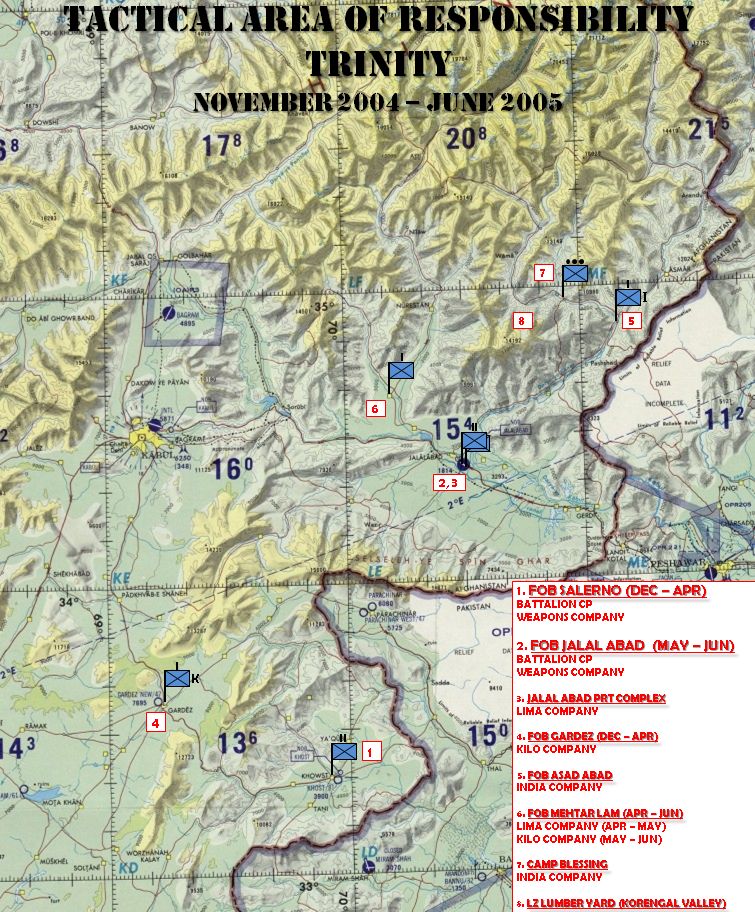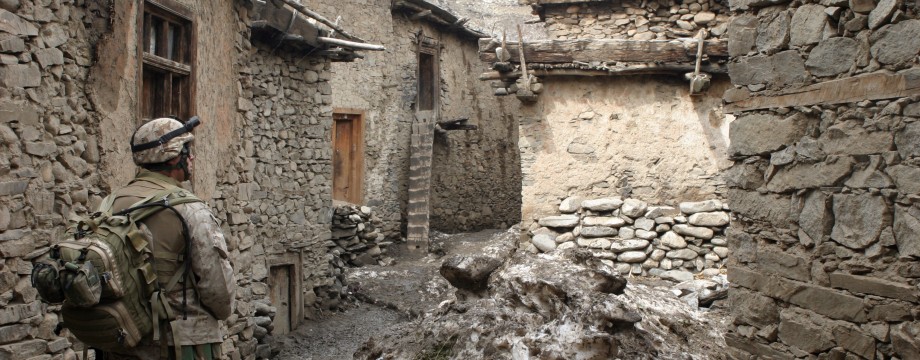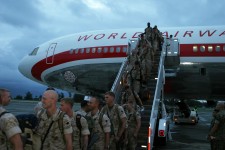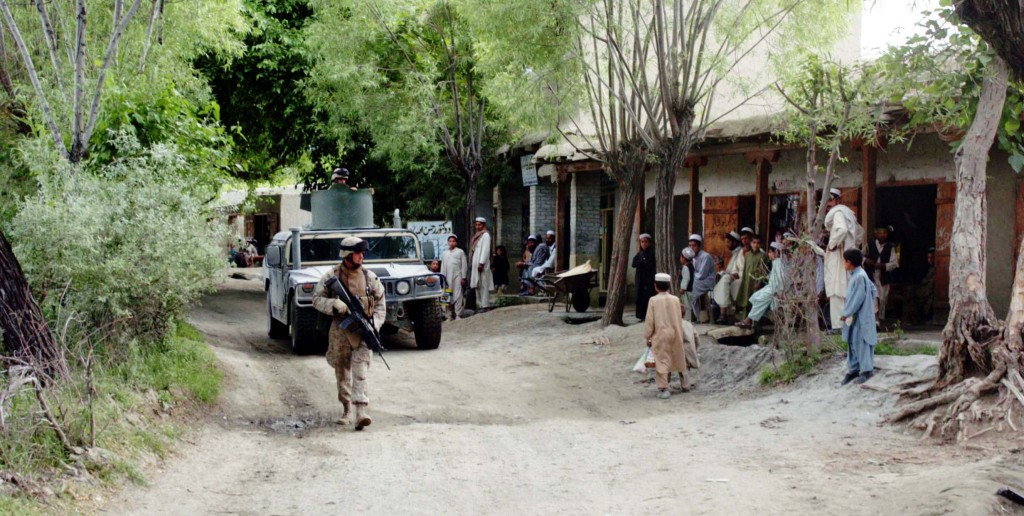Contents
Introduction
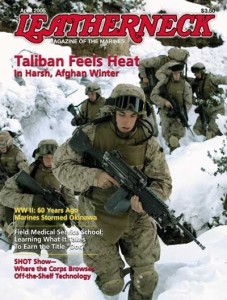
Lance Corporal Dan Robert, Lima Company
This page is dedicated to the U.S. service members of Task Force Trinity, who fought in the eastern provinces of Afghanistan during the 2004-5 timeframe. It highlights a story of selfless service and adds another chapter to the long, distinguished history of 3d Battalion, 3d Marines, “America’s Battalion.” It is a little known story as the media and most Americans were focused in this time frame on the war in Iraq. Most of our nation’s military resources were also dedicated to Operation Iraqi Freedom, making Afghanistan and Operation Enduring Freedom (OEF) an “economy of force” effort. As a result, Task Force Trinity, formed around a single Marine infantry battalion, assumed an area of operations the approximate size of West Virginia and without the advantages of modern road infrastructure. America’s Battalion constituted the Marine Corps’ only battalion in Afghanistan during this period, and faced a resurgent Taliban who had recovered from the initial shock of OEF, reorganized in Pakistan and was intent upon infiltrating back into Afghanistan.
This was a counter-insurgency campaign characterized by a competition for the support of the population. In this competition Task Force Trinity focused on creating security space to facilitate the building of civic institutions, while the Taliban and other anti-government forces pursued a course of intimidation and high profile attacks designed to discredit the fledgling Afghan government. Also in contrast, while conventional forces like Task Force Trinity focused on counter-insurgency, our special operations forces pursued a counter-terrorism strategy oriented at finding and destroying the Taliban’s leadership. These two approaches were often in conflict when 3/3 arrived. Synchronizing and integrating the two approaches was new and complicated, and Task Force Trinity played a significant role in advancing this effort.
Task Force Trinity’s campaign was also characterized by extremes in weather and terrain. At one point, for example, the temperatures for Company K were in the low 20’s in Gardez, while Company L was operating concurrently in the 60’s in Jalabad. (Later, Company L would operate in temperatures above 100.) Foremost, this was a MARINE campaign characterized by an expeditionary mindset, the willingness to undergo extreme discomfort for long periods of time in order to protect the population and close with an elusive enemy, and dauntless courage. This is the story of Marines like Corporal Ricky Schoener and Lance Corporal Nick Kirven who valiantly gave their lives while leading an assault on an enemy fortified cave in the Alishang Valley. It is the story of brothers bound eternally by shared sacrifice. It is a story of which I am honored to have been — and to be — a part.
— Brigadier General (Select) Norm Cooling, 13 October 2014
Timeline
July-August
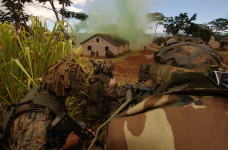
India Company at RIMPAC 2004
“I think if you’re asking me (about 3rd Marines) going to the Middle East or another theater that’s active in the global war on terror — very, very real.” – Lieutenant Colonel Norm Cooling, 21 July 2004 (Honolulu Advertiser)
In mid-July 2004, 3rd Battalion was in the final stages of Exercise Rim of the Pacific when battalion commander Lieutenant Colonel (LtCol) Norm Cooling received word that the battalion’s planned deployment as the ground element for the 31st Marine Expeditionary Unit had been cancelled. Instead the battalion would be deploying to Operation ENDURING FREEDOM in Afghanistan, where it would replace 3rd Battalion 6th Marines (3/6) in Regional Command (RC) East. With just three months to prepare, and no standard training program for Afghanistan deployments, the battalion staff hastily drew up a new pre-deployment training program (PTP) with higher headquarters. A group led by Major Patrick Beckett left for Afghanistan on 12 August to conduct a Pre-Deployment Site Survey, and brought back valuable information to augment the battalion’s training program. The month of August saw the battalion rapidly adding new gear and training requirements. M-16A2’s were upgrade to M-16A4’s and M4 Carbines. Marines were given a crash-course in Dari, the official language of Afghanistan, although it would later turn out that most Afghans in the area spoke Pashto. Most importantly 80 new Marines joined the battalion, which had started the month at only 65 percent deployable strength. Some of them them arrived in the middle of the Combined Arms Exercise at Twentynine Palms, fresh out of infantry school.
September-October
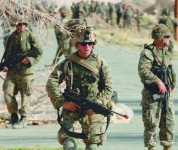
Kilo Company Marines during R-CAX at Twentynine Palms.
“What you will be doing will be the most important thing you will ever do,” – Otto Lehrack. Bridgeport, California
From August 20 and August 27, the battalion made their way to Twentynine Palms, California for the pre-deployment Revised Combined Arms Exercise (RCAX). There they joined the final supporting attachment sections they would take to Afghanistan as Task Force Trinity. At Twentynine Palms, the battalion broke down into companies, platoons, and even squads for a combination of live-fire training, as well as specialized counterinsurgency training in San Diego. On September 20, the battalion traded the hot Mojave desert for the cool mountains of the Sierra Nevada at the Bridgeport Mountain Warfare Training Center. Compressing a normal 2-3 week schedule into just ten days, the Marines conducted multiple long-range patrols, which culminated in a 14 kilometer battalion hike through the mountains. At the beginning of October, 3rd Battalion returned to Hawaii for two weeks of final deployment preparations, followed by a well-deserved two weeks of leave for the Marines and sailors. They were now ready for Afghanistan.
November
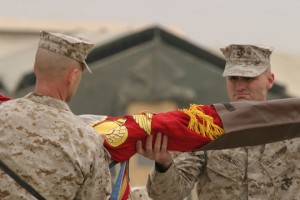
Battalion Staff LtCol Cooling uncases the battalion’s colors for the first time in Afghanistan.
“This is not a scheduled deployment. This is not routine. … We had just unpacked and we found out he was leaving.” – Cynthia Yantosca, wife of Gunnery Sergeant Joseph Yantosca (Honolulu Star-Bulletin)
Between the 1st and the 11th of November, the battalion gradually left Hawaii to take up positions in eastern Afghanistan, via Manas and Bagram Air Field. Despite all the preparation, the battalion’s first combat deployment since Desert Storm was a challenge for both its members and families. Some Marines who had been in the Corps over a decade were going on their first deployment. Many were not used to the new rapid operational tempo of a less than 1:2 deployment-to-dwell ratio, or two months back for every one month overseas. More than a few wives suddenly found themselves alone on a strange island with their husbands off in harms way, and left to run a family. To make matters worse, as 3rd Battalion left Hawaii its sister 1st Battalion in Iraq was beginning the savage Second Battle of Fallujah. Some Marines from 3rd Battalion, now part of 1st Battalion, were there. One, Lance Corporal Brian Medina, was killed in action on the 12th and became the second 3rd Battalion Marine to die in the Global War on Terror (after Steven Rintamaki). After arriving in Afghanistan, 3rd Battalion began its Relief in Place (RIP) with a welcoming from 3/6. The enemy welcomed 3rd Battalion too, with a taste of combat: an ineffective IED attack on Lima-3 during the RIP. By the 25th, 3/6 and 3rd Battalion had completed their RIP. That day, 3/6 cased its colors and turned over Tactical Area Of Responsibility (TAOR) TEUFELHUNDEN, which became TAOR TRINITY.
December
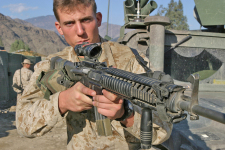
India Company Sgt Jason Burch showing his rifle, which was damaged during an engagement on Christmas Eve.
“I’m a f****** killer, what do you want me to do?” – India Company Marine
As December began, 3rd Battalion participated in Operation THUNDER FREEDOM, a nationwide effort to keep enemy forces off-balance during the traditionally low-kinetic winter months. The start of the month also saw Operation FAIRBANKS, the battalion’s first push into the Korengal Valley. India Company drew first blood near Nagalam on the 4th, killing an enemy combatant who was part of a group preparing an attack on Camp Blessing. The week after saw the battalion providing vehicle checkpoints in support of President Hamid Karzai’s inauguration. Parts of Kilo were then temporarily detached to Paktia Province for Operation SARATOGA. Although the battalion now had full control of its battlespace and was constantly sending patrols outside the wire, some Marines were still bored. When the Commandant paid a visit to Camp Blessing on the 16th, he was asked about 3rd Battalion going to Iraq where the action was. But the action was coming to them. On the 18th, India launched Operation CORNHUSKERS into the Korengal Valley. As the operation concluded, 2nd Squad from 3rd Platoon was ambushed by enemy forces on Christmas Eve, as well as a relief force from the Combined Anti-Armor Team sent to assist them. The enemy suffered two dead and eight captured. Several Marines were wounded and seven received awards for valor.
January
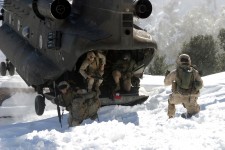
Lima Company Lima Company Marines jumping out the back of a CH-47 at the opening of Operation SPURS.
“Say hello to my little friend!” – Lance Corporal Ryan Lane, Firefight on 11 January
At the start of the New Year, 3rd Battalion’s contact with the enemy began increasing. A Weapons patrol near the village of Zambar came under attack, and there were other firefights in Asad Abad and Khogyani. Meanwhile, their Afghan National Army counterparts conducted a transfer of authority between the 23rd and the 3-3 Kandak and the battalion had to start its partnered operations all over. However, LtCol Cooling felt his biggest problem was the lack of coordination between 3rd Battalion and the Special Forces units operating throughout AO Trinity. At this stage in the war, the conventional units fell under CJTF-76 in Bagram, but the Special Forces answered directly to Special Operations Command (SOCOM). There was next-to-no coordination between the two organizations and LtCol Cooling was worried they were working at cross purposes. He and Operations Officer Major Andrew Priddy began working on a plan to integrate Special Forces into the battalion’s planned operations, which also had the side benefit of acquiring typically-scarce theater aviation assets. A typical “Cooling-Priddy” plan, which was hashed out by both 3rd Battalion and Special Forces staff, called for an initial insertion of Special Forces to neutralize targets, then the battalion’s line platoons to secure the ground, followed by medical and other units to conduct civil affairs missions. The first test of this type of operation was SPURS, conducted in the Korengal Valley in late January. SPURS was an unqualified success, resulting in four enemy detained and over 500 civilians receiving medical aid. The battalion then ended the month with a memorial to its comrades in 1st Battalion 3rd Marines, who had suffered 45 fatalities in Iraq, including 27 in a helicopter crash.
February
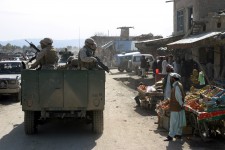
H&S Company Guard Force Marines conducting a mounted patrol in Khowst.
“In our situation, you can’t always locate, close with and destroy the enemy in a straight forward manner.” – Lieutenant Colonel Norm Cooling on Operation SABARI
Following Operation SPURS, 3rd Battalion began to shift its attention from Kunar Province to Laghman Province, although both remained volatile. On 15 February, a squad from Lima Company was attacked by 20-25 insurgents in Laghman Province’s, Alishang District with no casualties. India Company sought to build on the success of SPURS by launching regular operations in the Korengal starting on 12 February, in which individual platoons were rotated in and out of LZ Lumber Yard, and would last through the rest of the deployment. One of these early operations came under fire on 24 February, when a Korengal patrol base and helicopter bringing in reinforcements received harassing fire. Meanwhile, following the January attack near Zambar, Weapons Company had continued to operate in the Sabari District, carrying out humanitarian operations and gathering information on their attackers. By late February they had located them, and in a daring night raid on 26 February, captured an eight-man cell. That same day Kilo Company 3rd Platoon was unsuccessfully attacked by an unknown number of insurgents along the Khowst-Gardez (K-G) Pass near the village of Waza. As the month ended, India Company 3rd Platoon finished their two-week operation in the Korengal Valley and prepared for a turnover.
March
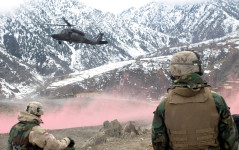
Kilo Company Kilo Marines conducting Operation MAVERICKS.
“We come up here hoping to get shot at, so the guys down there can either try running up here to get fired on or they can lob mortars. So basically we’re just a target and right now there’s only six of us.” – Corporal Gideon Hornung, Shoryak Valley, 12 March 2005
Enemy activity began to slowly pick up in March, starting with an IED attack on 3 March against a PRT convoy near Jalalabad, an ominous portent of a tactic becoming more and more common. Insurgent groups also stepped up their rocket attacks throughout the month, targeting FOB Jalal Abad, Salerno on the 11th and 22nd, Mehtar Lam, and Asad Abad. Throughout the month, India Company continued its operations in the in the Korengal Valley, uncovering several weapons caches and engaging in sporadic but heavy engagements on 22, 23, and 25 March. At attack on an observation post in the Shoryak Valley on 12 March left two Marines wounded. Afghan Security Forces also came under attack on 29 March, with an IED blast in Narang District that wounded six of them and an attempted VBIED attack in Jalalabad. In response, 3rd Battalion launched Operation MAVERICKS, another Cooling-Priddy operation, using Kilo and Lima Companies in Laghman Province. The battalion also stepped up its Close Air Support training and towards the end of the month sponsored a regional security conference. Both the outgoing and incoming commanders of CJTF-76, Major Generals Eric Olson and Jason Kamiya, visited the battalion, and as the month drew to a close, a Pre-Deployment Site Survey Team from 2nd Battalion 3rd Marines arrived, a reminder that the 3rd Battalion was entering the home stretch of its deployment.
April
May
June
“It’s a sign of success that we’re not getting shot at.” – Captain Eric Kelly, Operation CELTICS
The month of June found 3rd Battalion quickly transitioning with 2nd Battalion. Starting on 6 June, the two battalions began conducting their transfer of authority. Aside from sporadic firefights and enemy attacks, including several engagements by India Company near Dag village, the turnover was mostly uneventful. On 15 June TAOR Trinity became TAOR Kona and the tragic chain of events which in just two weeks would lead to Operation RED WINGS were set in motion. 3rd Battalion rapidly retrograded back to Hawaii, and the entire battalion had returned by 20 June. Following its return, the battalion conducted its company change of commands on 23 June, then immediately departed on a well-earned month of block leave the following day.
Key Units
Battalion Staff || Headquarters & Service Company || India Company || Kilo Company || Lima Company || Weapons Company
Key People
Lieutenant Colonel Norm Cooling
Majors Patrick Beckett || Andrew Priddy
Captains Kenneth Barr || Donald Blume III || James Sweeney
First Lieutenants Stephen Boada || Roy Bechtold || Jonathan Frangakis
Second Lieutenants Peter Ankney || Richard Posselt
Sergeant Major William Stables
First Sergeant Vincent Santiago
Gunnery Sergeant Chuong Nguyen
Staff Sergeants Michael Fay || Jason Ramseyer || Elcana Williams III
Sergeants Jairo Fredonis || Levar Palmer || Seth Stanton || Eric Toms
Corporals Troy Arndt || Rene Camarillo || Gideon Hornung || Patrick McKinney || David Parkinson || David Perinchief || James Rogers Jr || Richard Schoener* || Thomas Stickles || Joseph Summers Jr. || Patrick Whalen || Brandon Wittwer
Lance Corporals Andres Aguilar, Jr. || Brock Brothers || Jory Camille || Jose Marin Dominguez || Michael Estrella || Eric German || Jeffrey Globis || Adam Keliipaakaua || Nicholas Kirven* || Ryan Lane || Eric Lueken || William Leusink || Daniel Robert || Yull Estrada Rodriguez || Gary Soupir || Paul Szoldra
Italics indicates Marine is no longer alive. *Marine was killed in action or died on deployment.
Bases
FOB Salerno || FOB Jalal Abad (Camp Schoener-Kirven) || FOB Gardez || FOB Mehtar Lam || FOB Asadabad (Camp Wright / Camp Eggers) || Camp Blessing
Geography
Khowst Province || Nangarhar Province || Laghman Province || Paktia Province || Logar Province || Kunar Province: Korengal Valley
Cruisebook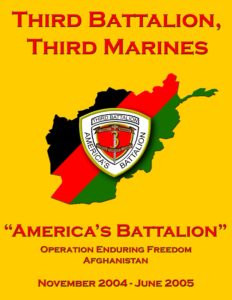
Key Documents
- Predeployment Site Survey After-Action Review
- 3/3 Command Chronology 01 July to 31 December 2004
- 3/3 Command Chronology 2005 01 January to 30 June 2005 (Part 1)
- 3/3 Command Chronology 2005 01 January to 30 June 2005 (Part 2)
- 3d Bn, 3d Mar OEF 90 Day After-Action Review
- 3d Bn 3d Mar OEF Final After-Action Review
- Meritorious Unit Commendation 3D BN 3D MAR, 2004-2005
- Norman Cooling, et al, “Retooling for Afghanistan“, Marine Corps Gazette, Vol. 93, Iss. 10, (Oct. 2009). Requires Access
- Norman Cooling, “To Integrate or to Deconflict“, Naval War College, (Jun. 2007).
Deployment Video
Map
